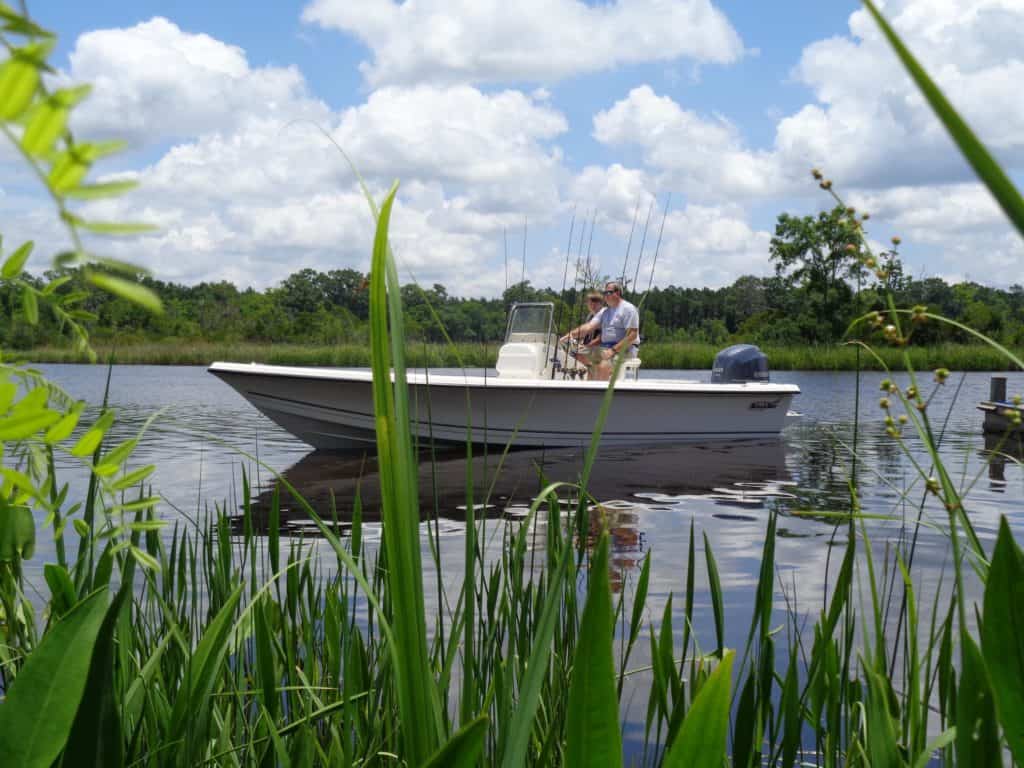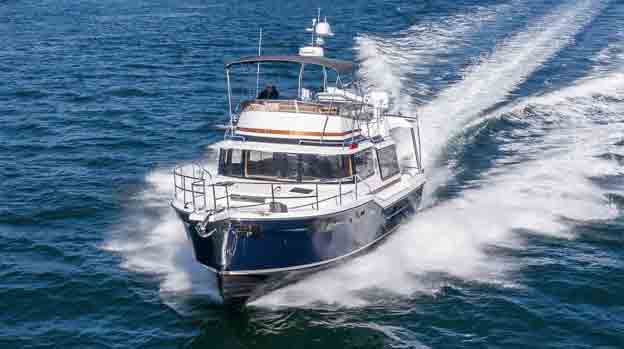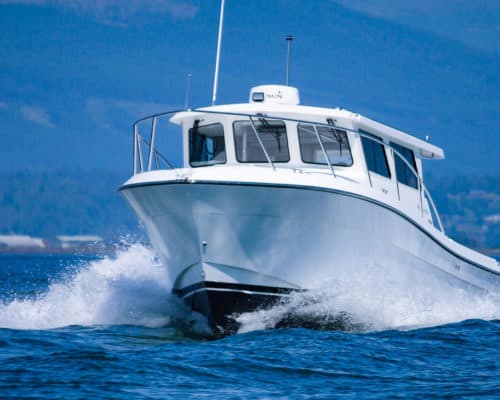Carolina Composites delivers a handy bay-style boat at a great price.
By John Page Williams
The weather was just right for a sea trial—wind out of the south at 12 to 15 knots against the beginning of an ebb tide; whitecaps just starting to appear.
Nick Doetsch and Mario Anello of Pasadena Boatworks were taking their first run in a new Bulls Bay 2200. I was glad to go along to see how this bay boat would perform, since it appeared to be a good light tackle fishing boat with the versatility to serve families well. All three of us came away impressed.
Bulls Bay boats are built by Carolina Composites of Walterboro, South Carolina, also makers of the Pioneer and Avenger brands. The Bulls Bay line includes five relatively simple, value-priced center console models. Their 230 and 200 come with deep cockpits, sharp deadrise angles, and T-tops, while the 2200, 2000, and 1700 are bay-type boats with low-sides, shallower deadrises, and no T-tops.
Bulls Bay 2200
- LOA: 21’/li>
- Beam: 8′ 6″
- Draft: 12″
- Transon Deadrise: 15″
- Weight: 2,200 lbs.
- Fuel Capacity: 50 gal.
Bay boats often get skeptical looks around the Chesapeake because people think their low freeboard makes them too wet in rough water. That judgement is not necessarily correct. Seaworthiness has more to do with hull shape than how high a boat’s sides are. The Bulls Bay 2200 is a good example. Its gently rising sheer and broad flare give the bow plenty of buoyancy to meet the seas, along with a self-bailing cockpit with large drains to get rid of any spray that comes aboard. Well-placed rails on the console, behind the helm’s leaning post, and along the cockpit sides give passengers plenty to hold
on to.
On the open Bay just outside the mouth of the Patapsco River, the bow’s sharp forefoot cleaved the short, two-foot seas well, while the 21-foot, eight-inch length and 15-degree running bottom allowed the hull to rise onto plane easily in the teens, giving us a wide range of speeds to adjust to the chop. That well-shaped bow damped the seas completely, keeping us dry. There wasn’t a drop of spray anywhere in the cockpit when we returned to the landing.
Anello loves to troll, so he simulated the technique at low speed in several directions, noting the hull’s easy motion and directional stability. With its wide, eight-foot, six-inch beam, the 2200’s hull is very stable. We drifted comfortably with the engine idling in neutral. To return to the river, we trimmed the engine up slightly and ran with the seas. The hull tracked well, with no tendency to wander. Though it performs well as is, I would add the optional trim tabs to fine-tune the 2200’s running angle and adjust side-to-side angle for quartering into seas.
Power for our test boat was a Suzuki 150, a strong engine that can push the 2200 into the upper 40s, but those speeds are rarely useful in the Chesapeake’s open waters. A better choice for most owners is Suzuki’s lighter, well-proven 140, which would still provide top speeds in the upper 30s, with plenty of power for carrying a family on a picnic, and excellent fuel economy. Cruising speeds would be anywhere in the 20s. That’s more than enough for running-and-gunning on breaking fish or a long day exploring the flats and grass beds of Tangier Sound or Mobjack Bay. Add the valuable ability to slow down efficiently into the teens, to cover water while looking for birds and fish, and to be comfortable when the going gets rough.
The 2200’s layout is simple. The broad, unobstructed bow deck holds a flush, pull-up cleat, an anchor locker for a Danforth-type hook, chain, and rode; a large central storage area for bulky items; a long, lockable storage compartment to port, and another to starboard with horizontal racks for four rods up to seven feet long. The console’s front seat holds a small livewell that could double as a cooler for lunch and beverages. Inside the console, there are spaces for up to three batteries—one for starting and two for a bow-mount trolling motor, plus a bit of additional storage. The dash has a panel for engine gauges, with space left over for an electronic display up to nine inches (diagonal measure) and a linked VHF radio. Each side of the console offers three vertical rod holders and a cup holder. The standard helm seat is a leaning post with four rod holders behind, grab bars, and secure space for a cooler/fishbox beneath. The stern deck provides a removable, central, padded seat over a large, oval livewell. On either side are finished storage compartments, while a hatch in front of the engine provides access to a well-arranged plumbing system for the livewell, optional raw-water washdown, scupper lines, and rigging tubes. My only gripe is that the storage compartments, while nicely gel-coated, prevent access to the insides of the transom and fittings like the forward ends of the scuppers. I’d rather they be simple lift-out trays
that allow better access to the sides
of the bilge.
This bay boat’s stability and broad foredeck are made for casting to fish. The stern deck also serves as a stable fishing platform. The shallow deadrise allows the 2200 to slip into shallow coves and creeks easily or pull up on a beach. The boat comes pre-wired for a bow-mount trolling motor. The wide-open cockpit invites easy bottom-fishing for panfish, with lots of storage for food and drink as well as tackle and bait for the whole family. Beyond fishing, adding the optional transom platform with telescoping ladder turns the 2200 into a fine swimming float, well suited for towing tubes.
For light tackle anglers and water-loving families, the Bulls Bay 2200 offers a simple, versatile, able vessel at an attractive price—equipped with a Suzuki 140, around $38,000.




